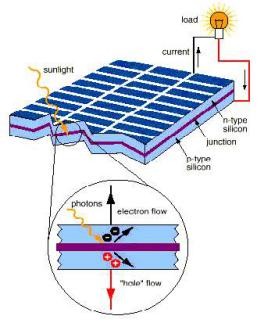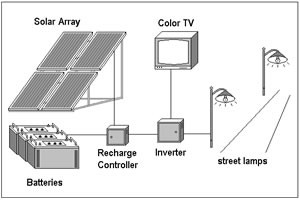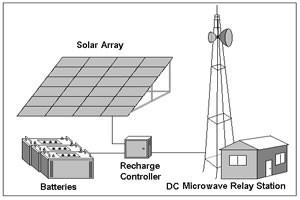Solar Panels and Photovoltaic Power Generation Technology Overview(QUENENG)
This article provides an in-depth exploration of the development history, working principles, and current applications of solar photovoltaic (PV) power generation technology. Since the invention of the first practical solar cell in 1954, solar energy technology has undergone several breakthroughs, gradually becoming one of the key technologies in the renewable energy sector. The article explains the photovoltaic effect, the fundamental characteristics of solar cells, and the components of photovoltaic power generation systems. By analyzing the efficiency improvement trends of solar cells and the structures of different power generation systems, this article offers a comprehensive perspective on solar energy technology. Furthermore, it explores practical applications of solar power generation, including off-grid and grid-connected systems, as well as applications in residential, commercial, and other settings. Through this content, readers can gain a thorough understanding of the potential and future development of solar photovoltaic power generation.
1. Development History and Current Status of Photovoltaic Power Generation
Since the invention of the first practical photovoltaic (PV) cell in 1954, solar photovoltaic power generation technology has made significant progress. However, the development of solar energy has been slower compared to the rapid advancements in fields like computers or fiber optics. This is partly because the demand for information is particularly strong, and conventional energy sources have been sufficient to meet human needs. The 1973 oil crisis and environmental pollution issues in the 1990s greatly accelerated the development of solar photovoltaic power. Below are the key milestones in the history of solar photovoltaic technology:
- 1893: French scientist Becquerel discovered the "photovoltaic effect".
- 1876: Adams and others discovered solid-state photovoltaic effects on metals and selenium.
- 1883: The first "selenium photovoltaic cell" was made, used as a sensor device.
- 1930: Schottky proposed the theory of the "photovoltaic effect" in Cu2O barriers.
- 1954: Bell Labs developed the first practical single-crystal silicon solar cell with a 6% efficiency.
- 1962: The photovoltaic conversion efficiency of gallium arsenide solar cells reached 13%.
- 1978: The U.S. built a 100 kWp solar photovoltaic power station on the ground.
- 1990: Germany launched the "2000 Rooftop Solar Program".
- 1995: High-efficiency concentrated gallium arsenide solar cells reached 32% efficiency.
- 1997: The U.S. proposed the "Million Solar Roofs Program", aiming to install solar cells in 1 million homes.
2. Introduction to Solar Cells
Solar cells, also known as solar chips or photovoltaic cells, are semiconductor thin films that directly convert sunlight into electricity using the photovoltaic effect. A single solar cell cannot be used as a power source; several cells need to be connected in series or parallel and sealed together to form a solar panel. Solar panels are the core component of solar power generation systems and the most critical part.
Types of Solar Energy
- Solar Thermal Utilization: Solar radiation is converted into heat energy, which can be used for thermal power generation.
- Solar Photovoltaic Power Generation: Solar radiation is converted into electricity through photovoltaic conversion devices, mainly based on the principle of the photovoltaic effect.
3. Working Principle of Solar Cells

Solar cells work on the principle of the photovoltaic effect. When sunlight strikes the semiconductor material, photons with energy greater than the bandgap excite electrons and create electron-hole pairs. These non-equilibrium carriers are separated by the built-in electric field at the P-N junction, with electrons moving toward the N-type region and holes toward the P-type region. This creates an electric potential across the P-N junction. When metal leads are attached to the P-type and N-type layers and connected to an external load, current flows through the external circuit, generating electrical power.
4. Characteristics of Solar Cells
The main characteristics of solar cells include:
- Rated Output Voltage: Under standard light conditions (irradiance of 1000 W/m², temperature of 25°C), the output voltage is about 0.48V.
- Negative Temperature Coefficient: For every 1°C rise in temperature, the voltage drops by approximately 2mV.
- Power Output: The output power of solar cells varies with sunlight intensity, climatic conditions, time, and location. On sunny days around noon, the power output is close to the rated value.
5. Selection of Solar Cells
When selecting solar cells, the output power is a key factor. The standard test conditions are:
- Irradiance: 1000 W/m²
- Air Mass: AM1.5
- Cell Temperature: 25°C
These conditions roughly simulate the sunlight at noon on a clear day. In reality, the output power of solar cells will fluctuate due to variations in light conditions and environmental factors.
6. Photovoltaic Effect
The photovoltaic effect refers to the phenomenon where light causes a potential difference between different parts of a semiconductor or a semiconductor-metal combination. In solar cells, this effect is used to convert solar energy into electricity. The core principle of solar cells relies on the P-N junction, which creates an electric field that separates electrons and holes, generating voltage and thus current.
7. Solar Power Generation Systems

Solar power systems can be divided into off-grid and grid-connected systems. The components of these systems vary slightly:
Off-Grid Solar Power Generation Systems
These systems are used in areas without access to the grid and generally include the following components:
- Solar Cell Array: Multiple solar panel modules arranged and connected in a specific pattern.
- Energy Storage Battery: Used to store electricity for use when the sun is not shining.
- Controller: Controls the charging process of the energy storage battery and includes various protective functions to ensure safe and stable operation.
- Inverter: Converts stored DC electricity into AC electricity.
- Distribution Box and Connecting Wires: Used to connect and manage the system components and power output.
Grid-Connected Solar Power Generation Systems

These systems are used in areas with grid access, and they can feed excess electricity back to the grid. Key components include:
- Solar Cell Array: Multiple solar panel modules connected together.
- Energy Storage Battery: Used to store electricity.
- Grid-Tied Inverter: Converts DC electricity from storage into AC electricity suitable for the grid.
- Distribution Box and Connecting Wires: Used to connect and manage the system components and power output.

Have more questions about our products or services?
The latest hot news you might like

Discover how solar panels power street lights, exploring the technology behind solar energy conversion, storage systems, and how solar-powered street lights are revolutionizing urban and rural lighting solutions.

Learn how AC Solar Hybrid Street Lights work, their advantages, disadvantages, system behavior in low-sunlight conditions, and why hybrid technology is ideal for regions with unstable sunlight.

Municipalities around the world are increasingly adopting solar-powered streetlights as part of their urban development strategies. Rising energy costs, the need for sustainable infrastructure, and government green initiatives are driving cities to switch from traditional street lighting to advanced LED solar streetlights.
Queneng Lighting provides municipalities with cost-effective, energy-efficient, and durable solar lighting solutions, ensuring safe and sustainable public spaces.

In recent years, the purchase of solar streetlights for municipalities has become a growing trend across the globe. Local governments are under pressure to reduce public expenditure, promote green energy, and create safer communities. Solar streetlights provide a reliable, cost-effective, and sustainable solution that meets these needs. Queneng Lighting, as a leading solar street lighting manufacturer, has supported multiple municipal projects worldwide with customized and energy-efficient solutions.
FAQ
Battery Types and Applications
Why do fuel cells have great development potential?
1) High efficiency. Because the chemical energy of the fuel is directly converted into electrical energy without thermal energy conversion in the middle, the conversion efficiency is not limited by the thermodynamic Carnot cycle; because there is no conversion of mechanical energy, mechanical transmission losses can be avoided, and the conversion efficiency does not depend on the size of the power generation. And change, so the fuel cell has higher conversion efficiency;
2) Low noise and low pollution. In the process of converting chemical energy into electrical energy, the fuel cell has no mechanical moving parts, but the control system has some small moving parts, so it is low-noise. In addition, fuel cells are low-pollution energy sources. Taking phosphoric acid fuel cells as an example, the sulfur oxides and nitrogen compounds they emit are two orders of magnitude lower than the U.S. regulations;
3) Strong adaptability. Fuel cells can use various hydrogen-containing fuels, such as methane, methanol, ethanol, biogas, petroleum gas, natural gas and synthetic gas, etc. The oxidant is inexhaustible air. Fuel cells can be made into standard components with a certain power (such as 40 kilowatts), assembled into different powers and types according to the user's needs, and installed in the most convenient place for the user. If necessary, it can also be installed into a large power station and used in connection with the conventional power supply system, which will help regulate the power load;
4) Short construction period and easy maintenance. After the industrial production of fuel cells is established, various standard components of power generation devices can be continuously produced in factories. It is easy to transport and can be assembled on-site at the power station. Some people estimate that the maintenance required for a 40-kilowatt phosphoric acid fuel cell is only 25% of that of a diesel generator of the same power.
Because fuel cells have so many advantages, both the United States and Japan attach great importance to its development.
Municipal and Public Infrastructure
What happens if the battery runs out of charge?
Our solar streetlights use advanced battery management systems to optimize energy usage. Even during prolonged cloudy or rainy periods, the lights can function at reduced brightness to conserve energy.
Can the lights be customized for specific municipal projects?
Yes, we offer tailored solutions to meet the unique requirements of different projects, including variations in design, brightness, height, and operation modes.
Battery fundamentals and basic terms
What is the electrochemistry of lithium-ion batteries?
The main component of the positive electrode of lithium-ion battery is LiCoO2 and the negative electrode is mainly C. When charging,
Anode reaction: LiCoO2 → Li1-xCoO2 + xLi+ + xe-
Negative reaction: C + xLi+ + xe- → CLix
Total battery reaction: LiCoO2 + C → Li1-xCoO2 + CLix
The reverse reaction of the above reaction occurs during discharge.
Public Gardens and Landscape Lighting
What happens if the solar light is not working properly?
If your solar light is not working properly, it could be due to a variety of reasons, such as dirt on the solar panel, insufficient sunlight, or battery issues. We recommend cleaning the panel and ensuring it receives enough sunlight. If the problem persists, please contact our customer service team for troubleshooting assistance.
Remote Areas Rural Development
Can solar streetlights integrate with smart technologies like remote monitoring?
Yes, our systems can include IoT features for real-time monitoring and control.

Introducing the Luqing Solar Street Light by Queneng, Efficient LED lighting powered by solar energy is perfect for illuminating outdoor areas. Harness the power of solar energy for sustainable, reliable street lighting. Ideal for eco-friendly, cost-effective outdoor illumination solutions.
If you would like more information about Queneng solar lighting solutions, please send us a message by filling out the form below. Our professional team will get back to you within 24 hours!
Rest assured that your privacy is important to us, and all information provided will be handled with the utmost confidentiality.
Schedule a Meeting

Book a date and time that is convenient for you and conduct the session in advance.
Have more questions about our products or services?



















